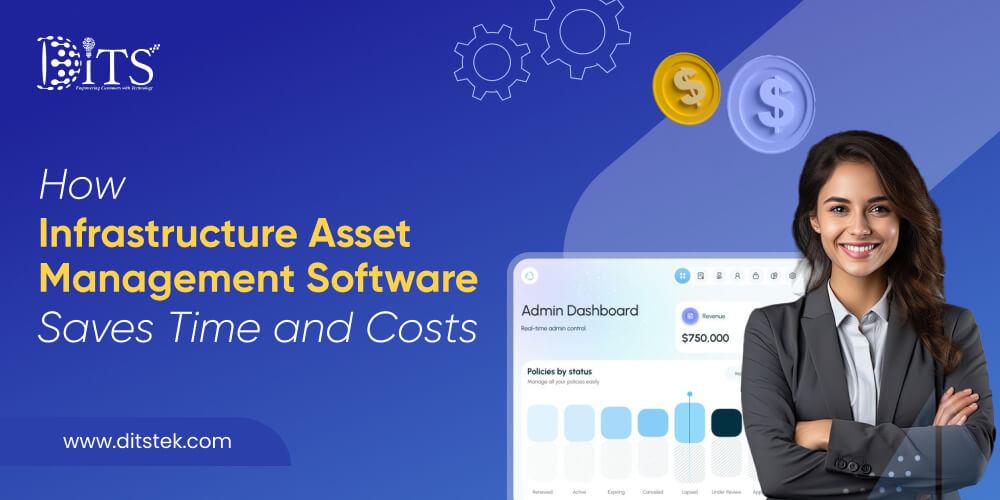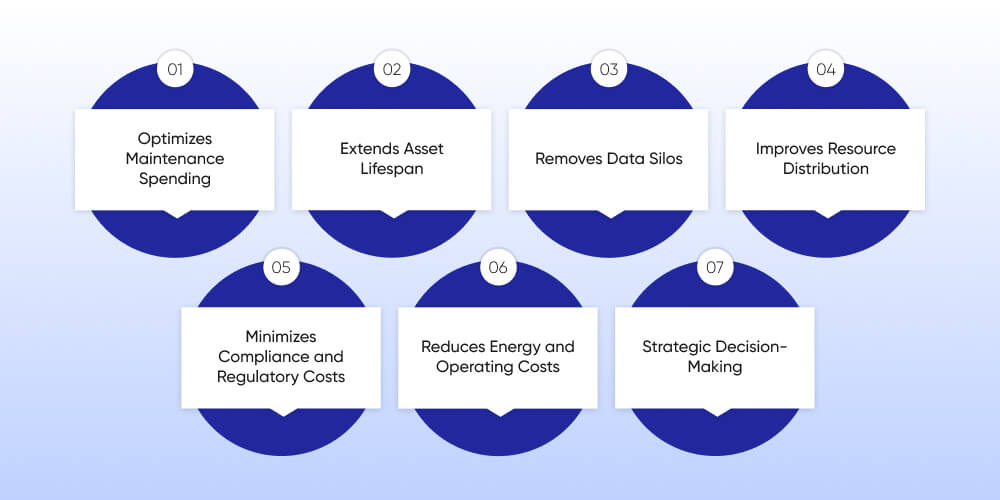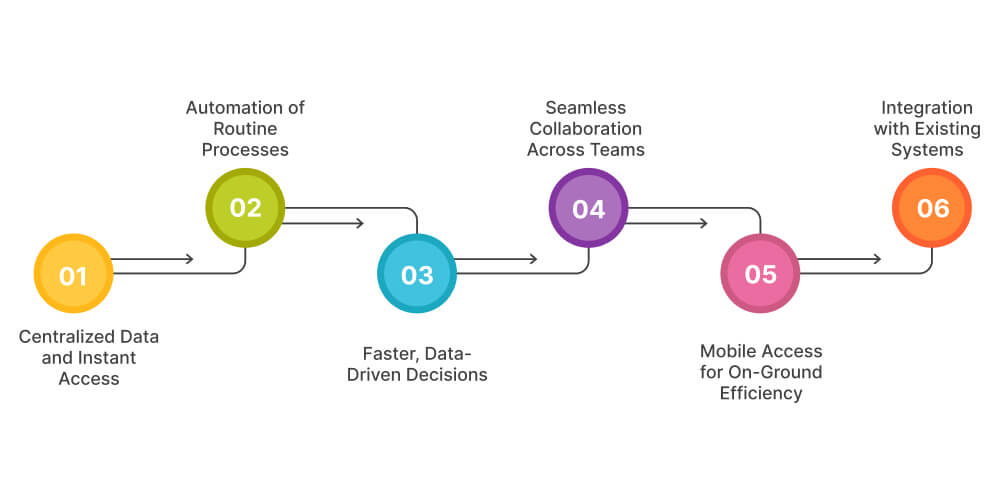How Infrastructure Asset Management Software Saves Time and Costs
Table Of Contents
Published Date :
04 Nov 2025
Managing a large-scale infrastructure is challenging for any organization. Roads, utilities, bridges, pipelines, or production machines in a manufacturing unit all need constant attention. And when they don’t get it, small issues turn into disruptions and downtimes.
That’s where infrastructure asset management software steps in. It gives organizations a smart way to track, maintain, and optimize their assets and the entire infrastructure.
What’s interesting is how fast organizations are adopting these tools. Many companies are already looking to asset management consulting for a deeper understanding of their asset efficiency and investment planning. These technologies together help businesses switch from reacting to problems to predicting solutions, resulting in savings in time and money.
What is Infrastructure Asset Management?
The practice of managing physical assets, such as buildings, road networks, production machinery, healthcare equipment, and transportation fleets, to ensure they deliver optimal performance is known as infrastructure asset management.
Asset management software analyzes an organization’s assets, their condition, maintenance history, performance metrics, and future repair schedules. It keeps track of every asset’s condition, value, and performance in one place. The goal of infrastructure asset management is to minimize the overall lifecycle expenses of assets while optimizing their value and lifespan.
With the right data at hand, organizations can plan repairs before breakdowns occur and cut the unnecessary repair costs. This proactive approach not only saves money but also improves the overall business productivity.
Is Your Infrastructure Underperforming?
Pinpoint inefficiencies with infrastructure asset management solutions that streamline maintenance, centralize records, and empower faster, data-backed decisions across teams today.
Key Ways It Helps Businesses Save Costs

Every organization wants the same benefits: few disruptions, low maintenance bills, and long-lasting assets. But those goals often feel out of reach when systems run on outdated tools or spreadsheets. That’s where infrastructure asset management software becomes essential for organizations. It helps businesses save money by lowering maintenance costs and maintaining assets at every level of operation.
Optimizes Maintenance Spending
Unplanned repairs can eat into the profits of any organization. With a smart asset management system, maintenance can be predicted in advance. It tracks patterns, alerts before breakdowns, and schedules servicing at the proper intervals. Preventive care always costs less than emergency fixes, and that’s the first thing organizations need to understand.
Extends Asset Lifespan
Assets that are regularly inspected and maintained last longer. By having a clear picture of every asset’s health, companies can delay asset replacements and get reliable performance from them. This helps them achieve high operational productivity and long-term savings.
Removes Data Silos
With one software platform housing all the data, everyone works with the same set of information. This removes confusion, time waste, and the need for duplicate work.
Improves Resource Distribution
Organizations pay costs for labor, materials, and equipment. An asset management system provides managers with visibility into resource usage. It helps managers balance workloads and identify overutilized and underutilized assets. Better resource management reduces waste and streamlines workflows.
Minimizes Compliance and Regulatory Costs
Industries like utilities, construction, and healthcare asset management face heavy regulatory requirements. Audit trails, inspection reports, and maintenance records must be precise and readily available. A centralized digital record keeps everything organized and accessible, preventing penalties while saving time during audits.
Reduces Energy and Operating Costs
Assets run more efficiently over time with optimized energy usage. If the company can keep track in real time, knowing how assets operate and when they spend too much, they can apply optimization strategies. This includes situations where machinery consumes too much energy, which is subtle but once we recognize its power to save costs, we find it easy to overlook.
Strategic Decision-Making
Beyond costing, this software system will provide data to support decision-making and budget planning. Decision makers can quickly identify where their assets are draining money, where they are receiving a healthy return on investments, and where to invest funds.
How It Saves Time Across Operations

Ask any operations manager what they wish they had more of; the answer is almost always time. Between maintenance scheduling, tracking inspections, and managing field teams, hours vanish before real work begins. That’s exactly where infrastructure asset management software makes a difference. It not only automates tasks but also saves time for people who need it most.
Centralized Data and Instant Access
With an asset management tool, employees don't need to go through folders or wait for reports from multiple departments. With all asset information stored in one system, teams can pull up the exact data they need instantly. Whether it’s an equipment maintenance record or an asset performance report, everything is accessible in seconds, not hours. That alone changes the daily pace of operations.
Automation of Routine Processes
Routine maintenance, inspection scheduling, and work order creation are all done automatically. The system allocates tasks, sends out reminders, and monitors completion without any manual management. It not only reduces the administrative burden but also allows field personnel to focus on their work rather than constantly asking for updates.
Faster, Data-Driven Decisions
Every delay in decision-making leads to a loss of money. Managers can identify inefficiencies early and take preventive action with the help of real-time dashboards and visual reports. Decisions that used to take several weeks of manual analysis can now be made in a matter of hours.
Seamless Collaboration Across Teams
When everyone works in the same digital environment, it minimizes the communication gaps between departments. Collaboration becomes much easier when engineers, finance teams, and project managers all operate within the same system. Everyone has access to the same data, updates happen automatically, and there is no confusion regarding asset status or who is responsible.
Mobile Access for On-Ground Efficiency
The field teams have the advantage of accessing asset data directly from their mobile devices, updating inspection results, or uploading images in real time. This facilitates eliminating interdepartmental email exchanges and office visits. The moment an issue is reported, it becomes visible to all who need to take action.
Integration with Existing Systems
Most asset management software integrates with ERP, GIS, or project management tools quite smoothly. Such interoperability eliminates the need for data re-entry or switching between platforms, resulting in significant time savings in day-to-day workflows.
All this comes together to produce one significant benefit - speed. Operations become faster, communication improves, and decisions are made at the right time. Time saved in operations can be reinvested in growth, innovation, and customer value.
Looking to Future-Proof Investments?
Build capital plans with infrastructure asset management solutions that align risk, performance, and ROI, guiding smarter expansion without expensive surprises.
ROI Perspective: The Tangible and Intangible Returns

Every investment has to justify its existence; infrastructure asset management software is no exception. However, the return for this investment is not simply in numbers; rather, it is in the efficiency, effectiveness, and satisfaction, knowing that your property won't incur more damage from inefficiencies and failures.
Tangible Returns That Can Be Measured
Most organizations identify the financial benefits 1 year after implementation. Maintenance costs can drop quickly by as much as 20% and 30% because issues are identified long before it become a large expense. Equipment downtime is significantly reduced, resulting in far less interruption to production or service. Since many repairs will not be emergency repairs, monthly operating costs are also reduced.
Most organizations are surprised by an energy-savings cascade that becomes a bonus. Regularly maintained machinery uses less energy and delivers more efficiency. Add in the benefits of reduced paperwork, reporting, or scheduling, and once again, small efficiencies turn into a measurable return on financial investment.
Intangible Benefits that Compound Over Time
In addition to quantifiable savings, ROI also has a human facet. Teams are more confident in their decisions because they have trustworthy data at their fingertips. Even communication between departments is improved because they are all working from the same system.
Then, there is peace of mind. The organization can have less worry knowing that assets are being monitored and maintained correctly. This trust is often extended to other aspects of the organization, leading to better customer service and stronger client relationships.
The Ripple Effect on Long-term Planning
As the software collects relevant data, managers can project maintenance budgets, predict asset replacements, and capital expenditures in advance. This predictive feature allows organizations to mitigate financial shocks and make decisions with confidence about long-term goals.
In summary, ROI is not just about reducing costs; consistency and predictability go a long way toward fostering a sustainable culture that enables practical databases that effectively support continuous growth.
How DITS Helps Businesses Build Efficient Infrastructure Asset Management Solutions
At DITS, we know that managing infrastructure assets involves more than managing equipment. It requires performance improvement, risk reduction, and maximization of return on investment. For this reason, our team develops solutions for each organization that address specific driving goals instead of offering an ill-fitted, generic, one-size-fits-all platform.
Our process begins with understanding your workflows and pain points. Whether it is utility networks, construction assets, or fleet and equipment management, we design systems and platforms to provide visibility and control at all levels of operation, helping businesses adopt a proactive approach.
What makes our process different is how deeply we integrate technology into development. We use AI across multiple stages, from software development and testing to code review and performance optimization. It helps us maintain precision, deliver faster, and ensure every solution is scalable and reliable.
For businesses that want to modernize their infrastructure management, DITS builds systems that grow with business, solutions that save time today and create value tomorrow.
Ready to Cut Maintenance Costs?
Discover infrastructure asset management solutions that reduce downtime, extend asset life, and unify data for decisive planning across complex operations.
Conclusion
Organizations that rely on manual tracking and spreadsheets waste time and pay for the lack of planning they struggle with. Therefore, migrating to infrastructure asset management software becomes a business necessity rather than a business improvement.
This technology supports the organization in working more efficiently, minimizes downtime, and improves the organization's ability to make data-driven decisions. This is not just saving money, but giving teams control, visibility, and confidence in every decision they make.
At DITS, we offer custom software development services with intelligent automation, analytics, and modern architecture. Most of our experience has come from asset-heavy industries such as transportation, utilities, and construction, and we build systems that yield fast operations, fewer breaks, and savings you can quantify.
The future of infrastructure management is proactive, connected, and intelligent. Organizations that transition early will not only save valuable time and money but lead the wave of change the industry is seeing.
FAQs
1. What is infrastructure asset management software?
Infrastructure asset management software assists users in monitoring, managing, and optimizing physical assets like roads and bridges, utilities, assets, and facilities. It provides an overall view of asset performance and provides teams with the useful information necessary to plan maintenance and control operating costs.
2. How does this software reduce overall costs?
Using smart data and automation, the software will offer efficiency to identify when assets need servicing prior to breakdowns, also preventing emergency repairs; ultimately prolonging the life of assets and lowering maintenance costs. After each service or preventative action, the company will spend less on unplanned maintenance and greater focus on overall site improvement.
3. Can small or mid-sized organizations use it effectively?
Yes, certainly. A small construction firm or a municipal department, any organization responsible for managing multiple assets, is capable. Regardless of organization size, the software organizes asset management, minimizing time and errors associated with manual reporting, allowing teams to focus on productive work and less on tracking maintenance.
4. How does infrastructure asset management software save time?
Software organizes and automates repetitive functions such as inspection scheduling, maintenance alerts, and reporting. Resources and energy spent on manual data collection or assumptions now become obsolete, and in each case, the real-time dashboard allows asset health to be viewed almost immediately. Everything is organized, traceable, and easy to access.
5. What separates DITS from generic software providers?
For starters, we provide custom-built software solutions tailored to your specific asset types, maintenance goals, and reporting needs, unlike proprietary tools. We ensure compatibility with existing software and continue to grow with your business if you need to expand your infrastructure.

Dinesh Thakur
21+ years of IT software development experience in different domains like Business Automation, Healthcare, Retail, Workflow automation, Transportation and logistics, Compliance, Risk Mitigation, POS, etc. Hands-on experience in dealing with overseas clients and providing them with an apt solution to their business needs.
Recent Posts

Learn the automotive software development cost breakdown. Discover key pricing factors to help plan your budget and invest wisely in custom automotive software.

A practical breakdown of transportation management application development costs, covering scope, technology, and strategic choices that shape budgets and long term operational value for businesses.

Protect and scale your law firm with expert IT consulting from Ditstek Innovations. We build solutions for security, compliance, and long-term growth.
